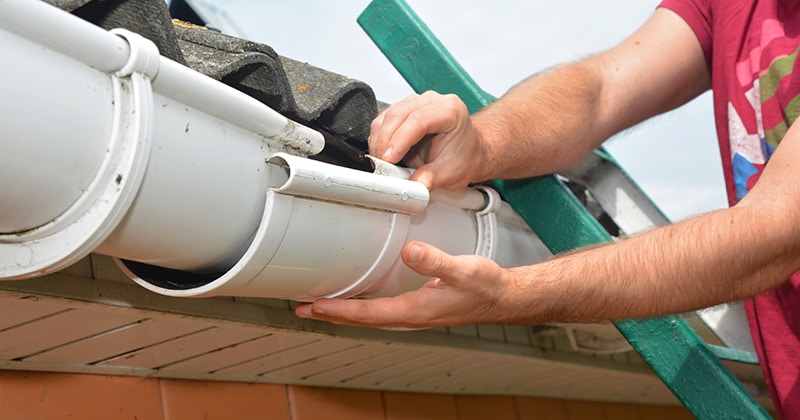Your clients have chosen you to install a brand-new gutter system. Congratulations!
They are paying an average of $1,166. It’s a significant investment, and you want to make sure you give them excellent service.
You want the new gutters to perform their function without a hitch. You also want to avoid common pitfalls that can lead to costly issues in the future. These include water damage and stubborn clogs.
Learning how to measure gutter size is a must. Only then can you deliver accurate and durable results.
Not sure where to start? This guide has you covered.
First, we’ll discuss why it’s important to measure correctly. Then, we’ll break down the process step by step.
The industry is always innovating, which is why we’ll also look at some advanced tools. These give you the most precise gutter sizing measurements.
Finally, we’ll share our top takeaway tips.
Continual learning helps you become the best roofer you can be. You can delight your customers, who will be more than happy to share their five-star experience. That means more business coming your way.
Sound good? Great. Let’s get started.
RELATED ARTICLE: Roof Estimating 101: How to Estimate a Roofing Job

The Importance of Correct Gutter Sizing
Accuracy is everything when it comes to construction and home improvement. Gutter sizing is no exception.
Here are some of the reasons why you must ensure you use the right gutter size for the job:
- The right gutters enable water to flow off the roof. Water won’t pool on the roof and damage it. This extends the lifespan of the roof.
- Gutters that are too small get clogged easily. Leaves, twigs, and debris can block water flow. Frequent clogs lead to overflow, mold growth, and even insect infestations. This can cause health issues and damage to the home.
- Water spilling over the sides of small gutters can damage the home’s exterior and landscaping. It can also seep into the basement, which can result in all sorts of nasty and costly problems.
- Installing the right size gutters builds your reputation as a professional roofer. Customers value your expertise and trust your services. You attract more word-of-mouth referrals. This helps you reach your growth goals.
- Homeowners prefer gutters that need less maintenance. Properly sized gutters are less likely to get clogged. This means they won’t need to be cleaned as often. It saves time for both you and your clients.
- Live and work in a cold area? You need to be aware of ice dams. These can form if gutters are too small. They cause damage to both the gutters and roof.
- Oversized gutters can be heavy and unsafe. They may pull away from the roof. Correctly sized gutters are more secure.
- Properly sized gutters look better. They appear in proportion. They match the home’s design and add to its curb appeal.
To deliver these benefits to your customers, you’ll need the right tools. Here’s a list of the essentials:
- A sturdy ladder helps you reach the gutters.
- A tape measure helps you record accurate measurements.
- Keep a notepad handy to jot down measurements and notes.
- Always wear safety gear, including gloves and sturdy footwear.
- A level helps you check the slope of the gutters.
- Use a chalk line to mark straight lines for gutter placement.
- A plumb bob helps you find the exact vertical line from the roof to the ground.
FROM ONE OF OUR PARTNERS: The 7 Best Gutter Scoops for Professional Gutter Cleaning
How to Measure Gutter Size in 11 Steps
You know why it’s important. You’ve got your tools together. Now, it’s time to unpack how to measure gutter size.
Follow these 11 steps.
Start at the Beginning: Measuring the Roof Area
Step 1: Measure the Length of the Gutter Run
- Use a sturdy A-frame or straight ladder with a stabilizer attachment.
- Climb up to the gutter. Carefully extend a measuring tape from one end of the gutter to the other.
- Record the measurement on paper or a note-taking app.
- If your tape measure can’t reach the entire length, mark your place with chalk.
- Continue this process until you’ve measured the entire gutter system or the section that needs replacing.
- Add together all your measurements to calculate the total linear feet needed.
Step 2: Measure the Width of the Gutters
- Measure the gutter’s width at both ends. Measure it at the midpoint, too.
- Add these numbers together. Divide this by 3. This will give you an average width.
Tip: This average provides the most accurate width. It helps you take slight variations into account.
Step 3: Measure the Depth of the Gutters
- Measure from the top edge to the bottom edge of the gutter to find out its depth.
- Measure at both ends and the midpoint.
- Use the average of these measurements.
Tip: Keep in mind that wider gutters tend to be a bit deeper. Depth can also vary by style (e.g., K-style compared to half-round).
Determining Roof Dimensions
Step 4: Measure the Roof Area
- Measure the length and width of each roof section.
- Multiply the length by the width to get the square footage of each section.
- Add the square footage of all sections to get the total roof area. This information will help you figure out the gutter capacity needed.
Step 5: Calculate the Roof Pitch
- Measure the vertical rise over a 12-inch horizontal run.
- Divide the vertical rise by 12 to get the roof pitch.
Tip: Here’s the roof pitch formula: Roof pitch = vertical rise / 12-inch horizontal run
The result is usually expressed as a ratio. For example, if the rise is 4 inches, the roof pitch is 4:12.
Placing the Downspouts
Step 6: Determine Downspout Placement
- Plan the placement of downspouts based on the gutter run.
- Mark the locations on your measurements.
Tip: In most cases, you’ll need one downspout for every 20 to 30 feet of gutter.
Adjusting for Any Obstacles
Step 7: Account for Obstacles
- Find obstacles like corners, chimneys, or vents.
- Adjust your measurements to include these elements.
Step 8: Calculate the Slope of Your Gutters
- Gutters need a slope of at least 1/4 inch for every 10 feet of length. Typically, roofers use a slope of 1/2 inch per 10 feet.
- Calculate the slope using your measurements. For example, if the gutter is 40 feet long, the side with the downspout should be 1 inch to 2 inches lower than the other end.
Finalizing Your Measurements
Step 9: Measure the Shape of Your Gutters
- Sketch your gutter’s cross-section.
- Label the sketch with the gutter’s dimensions.
Tip: You can even trace the profile of the gutter. This can make your sketch even more accurate.
Step 10: Choose the Right Gutter Size
- Based on your measurements, choose the right gutter size. Common sizes include 5-inch and 6-inch gutters.
- Don’t forget to think about the roof’s area and local rainfall patterns. You might need larger gutters in areas that experience a lot of rain.
Step 11: Check for Local Codes and Regulations
- Check that your measurements and plans follow local building codes.
- See if there are any specific gutter sizes and installation requirements.

Advanced Tools to Ensure Precision in Gutter Sizing
Razor-sharp precision can make all the difference to the quality of your work. That’s why more and more roofers are using advanced tools.
One example is professional aerial measurements. This uses technology to measure roofs from above.
You don’t need to take physical measurements. It’s a fast, accurate, and safe way to do your job.
Here’s how aerial measurements work:
- Drones or satellites capture high-resolution images of the roof.
- The captured images are uploaded to specialized software. This analyzes the images and extracts measurements.
- The software generates a comprehensive report. It gives you all the measurements you need for accurate gutter sizing.
- The software also looks for inconsistencies. It cross-references images and data points.
Looking for an easier way to measure? Try RoofSnap’s gutter measurement service and get your first order free.
8 Benefits of Professional Aerial Measurements
Aerial measurements offer many benefits that streamline your processes and improve your work’s quality. Here are eight:
- Aerial measurements are precise. You get the exact dimensions of the roof—no more guesswork or human error.
- This method saves a lot of time. You don’t need to spend hours on the roof fumbling with measuring tape and chalk.
- Roof work can be dangerous—over 2,500 roofers get injured on the job each year. Aerial measurements can lower the risk of accidents and injuries.
- Aerial tools capture the entire roof area. They provide a complete view. This is especially useful for large or complex roofs.
- Many aerial measurement tools come with software. This can calculate gutter sizes based on the roof dimensions.
- You can use aerial measurements to make your workflow a little more optimized. You can plan and execute gutter installations even faster. Speedier project completions aren’t just good for your bottom line. They delight your customers, too.
- Aerial measurements give you reliable results every single time. You can work confidently know the measurement is precise—regardless of who is taking it. This is important if you have employees.
- Aerial measurements save money in the long run. They reduce labor costs and minimize errors. This means fewer reworks and less material waste.
FROM ONE OF OUR PARTNERS: The 10 Best Gutter Vacuums for Professional Gutter Cleaning
Top Tips for Measuring Gutters
Here are some top tips to help you get the right measurements every time:
- Invest in quality tools. Use a good ladder, tape measure, level, and safety gear. Quality tools give you accurate measurements and keep you safe.
- Measure twice. Always measure each section more than once. Double-checking helps catch any mistakes before it’s too late.
- Use aerial measurements. If possible, use drones or satellite imagery. These tools provide accurate data and save time.
- Document everything. Write down all measurements and details. Keeping good records prevents errors.


